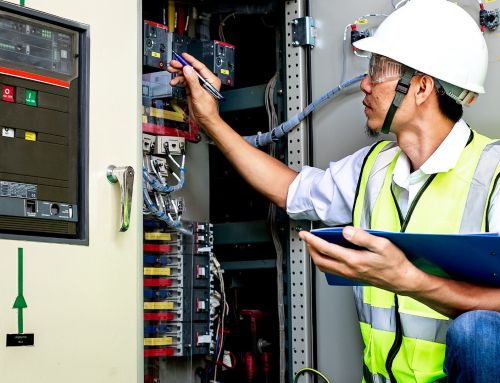
Amidst the maze of fire risk assessment procedures lies a path paved with caution and meticulous attention.
As I navigate through the five essential steps, from hazard identification to planning and training, I am reminded of the critical role each phase plays in safeguarding lives and property.

Ensuring compliance and readiness is not merely a checklist exercise but a strategic endeavor that demands dedication and precision.
The journey through these steps unveils a tapestry of proactive measures that hold the key to effective fire risk management.
Understanding Fire Risk Assessment
Understanding Fire Risk Assessment involves meticulously examining premises and individuals to identify potential fire hazards and risks for effective prevention and safety measures. Risk evaluation is a crucial aspect, requiring a comprehensive analysis of the environment to pinpoint vulnerabilities.
Hazard identification plays a pivotal role in this process, as recognizing potential dangers like faulty wiring or blocked exits is essential for developing robust safety measures. Emergency preparedness is another key component, ensuring that proper protocols are in place to address fire incidents promptly.
Risk mitigation strategies must be carefully crafted to minimize the likelihood of fires and their potential impact. By thoroughly evaluating risks, identifying hazards, implementing safety measures, preparing for emergencies, and mitigating risks, a solid foundation for fire prevention and safety can be established.
This meticulous approach not only enhances overall safety but also fosters a proactive attitude towards fire risk management.
Identifying Potential Fire Hazards

Upon evaluating fire risk assessments, the process of identifying potential fire hazards emerges as a critical step in ensuring comprehensive safety measures.
- Fire hazard identification: Scrutinizing areas for potential sources of fire.
- Risk assessment techniques: Utilizing methodologies to evaluate the likelihood of fire hazards.
- Hazard mitigation strategies: Developing plans to reduce or eliminate potential fire risks.
- Fire prevention measures: Implementing actions to prevent fires from occurring.
In the meticulous process of fire risk assessment, one must keenly observe surroundings for any elements that could spark a fire. Whether it be faulty wiring, flammable materials, or inadequate storage of combustibles, a thorough examination is essential. By employing various risk assessment techniques, hazards can be pinpointed, and appropriate hazard mitigation strategies can be put in place to enhance fire safety.
Moreover, proactive fire prevention measures should be implemented to minimize the likelihood of fire incidents. Through meticulous safety planning approaches, a comprehensive fire risk assessment can be achieved, ensuring the safety of all individuals in the environment.
Recognizing At-Risk Individuals
When identifying at-risk individuals in fire risk assessment, it’s crucial to consider various factors that may impact their safety in the event of a fire. Vulnerable populations, including individuals with disabilities or mobility issues, those working with flammable materials, and people needing extra evacuation support, require special attention. Disability accommodations and safety measures must be in place to ensure their well-being during emergencies. Emergency response plans should cater to their special needs, providing inclusive fire safety and prevention strategies.
High-risk employees, such as those in roles involving hazardous materials or processes, may necessitate evacuation assistance tailored to their specific requirements. Evacuation plans should be comprehensive and account for the diverse needs of all individuals in the premises. By recognizing and addressing the unique challenges faced by at-risk individuals, fire risk assessments can better safeguard the safety and security of everyone in the event of a fire.
Preventive Measures and Actions
To enhance fire safety preparedness, implementing proactive preventive measures and actions is essential in mitigating potential risks and ensuring the safety of individuals and premises.
- Fire Prevention: Regularly inspecting for fire hazards and enforcing safety protocols.
- Safety Measures: Installing fire alarms, fire extinguishers, and emergency lighting systems.
- Risk Mitigation: Developing evacuation plans and conducting fire drills periodically.
- Hazard Identification: Identifying potential fire risks such as faulty electrical equipment and flammable materials.
Recording and Planning Strategies
After establishing preventive measures and actions, the focus shifts towards implementing effective recording and planning strategies in fire risk assessment and management. Emergency drills play a vital role in ensuring readiness and familiarizing individuals with evacuation procedures.
Safety plans outline detailed steps to follow in case of a fire emergency, helping to minimize chaos and ensure swift response. Designating Fire Marshals who are well-trained in fire safety protocols enhances coordination during evacuations and emergency situations.
Providing evacuation support for individuals with specific needs or disabilities ensures no one is left behind during a crisis. Regular equipment maintenance is crucial for the reliability of fire safety tools such as fire extinguishers, alarms, and sprinkler systems.
Importance of Fire Safety Training

The significance of fire safety training can’t be overstated in ensuring preparedness and effective response in emergency situations.
- Employee education: Providing comprehensive training programs to ensure all staff are aware of fire hazards and emergency procedures.
- Safety drills: Conducting regular drills to practice evacuation protocols and test the effectiveness of safety measures.
- Emergency preparedness: Equipping employees with the knowledge and skills needed to respond swiftly and appropriately in case of a fire emergency.
- Compliance training: Ensuring all employees are educated on relevant fire safety regulations and guidelines to maintain legal compliance.
Employee education through fire safety training is crucial for enhancing emergency preparedness, promoting compliance with regulations, and mitigating risks effectively. By conducting safety drills and offering compliance training, organizations can proactively address potential fire hazards and ensure a safe environment for all occupants. Investing in fire safety training not only protects lives but also safeguards property and maintains business continuity.
Reviewing and Updating the Assessment
Regularly updating and reviewing the fire risk assessment ensures that safety measures remain effective and compliant with regulations. Continuous improvement is key in ensuring that the assessment reflects any changes in the environment, operations, or regulations.
This process involves ongoing risk mitigation strategies to address new hazards promptly. Emergency preparedness is enhanced through regular reviews, ensuring that all emergency procedures are up to date and well-understood by all staff.
Compliance monitoring is crucial to guarantee that the assessment aligns with the most current legal requirements. Safety enhancement is achieved by identifying areas where safety measures can be improved or updated to provide a higher level of protection.
Frequently Asked Questions
How Can Businesses Ensure That Their Fire Risk Assessment Is Tailored to Their Specific Industry or Type of Premises?
To ensure a tailored fire risk assessment for my industry or premises, I analyze industry-specific guidelines, customize assessment to business needs, adhere to specific industry standards, implement premises customization, and address unique risks.
What Are Some Common Challenges Faced by Property Owners When Trying to Implement Fire Safety Measures in Older Buildings?
Implementing fire safety measures in older buildings presents challenges like building retrofits for compliance, cost implications, historic preservation restrictions, and structural limitations. Overcoming these hurdles requires creative solutions and adherence to safety standards.
Are There Any Specific Considerations That Need to Be Taken Into Account When Conducting a Fire Risk Assessment for High-Rise Residential Buildings?
When conducting a fire risk assessment for high-rise residential buildings, considerations include building materials’ flammability, evacuation routes’ accessibility, fire suppression systems’ effectiveness, emergency lighting’s reliability, and smoke ventilation’s efficiency. Prioritizing safety through thorough evaluation is crucial.
How Can Employers Effectively Communicate Fire Safety Procedures to Employees Who Speak Different Languages or Have Varying Levels of Literacy?
To effectively communicate fire safety procedures to employees with diverse language abilities, I recommend utilizing multilingual signage, visual aids, training videos, language interpreters, and simplified instructions. These methods ensure comprehension and adherence to safety protocols.
What Are Some Innovative Technologies or Tools That Can Assist in Enhancing Fire Safety Measures Beyond Traditional Methods Like Fire Alarms and Extinguishers?
Smart sensors, virtual reality, drones monitoring, artificial intelligence, and IoT integration are innovative tools enhancing fire safety. They provide real-time data, predictive analytics, and automated responses, improving risk assessment accuracy and emergency response efficiency.
Conclusion
In conclusion, conducting a thorough fire risk assessment is essential for identifying and mitigating potential hazards to ensure the safety of individuals and premises. By following the five critical steps of assessment, we can proactively manage fire risks, enhance safety measures, and uphold compliance with regulations.
Regular reviews and updates are key to maintaining preparedness and safeguarding the well-being of occupants, employees, and the public. Prioritizing fire safety through meticulous planning and training is paramount for a secure environment.
About the Author: LandlordCertificate
Related Posts
Get Social
Recent Posts
- Fire Risk Assessment London Complete Guide to Compliance and Legal Responsibilities
- The Role of EICR London in Maintaining Safe Properties
- Fire Safety Report as a Smarter Way to Prove Compliance
- EICR Test and Modern Challenges in Property Safety
- Gas Safety Certificates: A Complete Guide for Property Professionals












